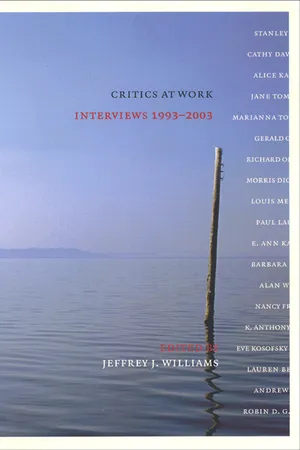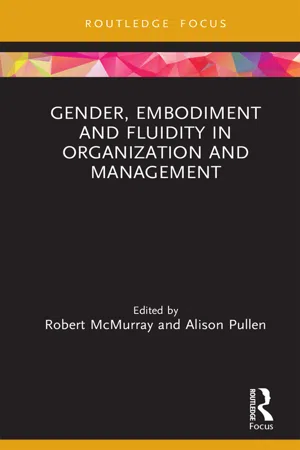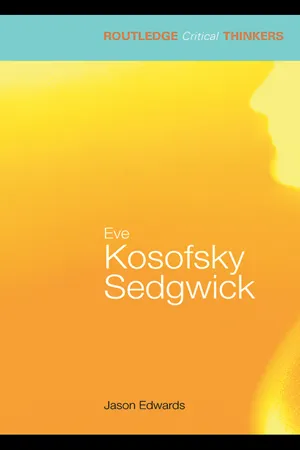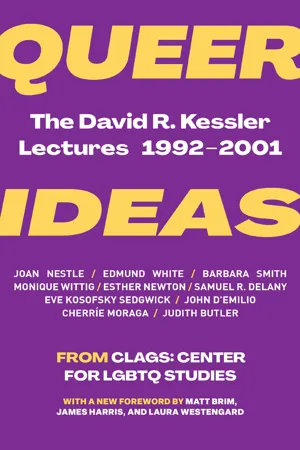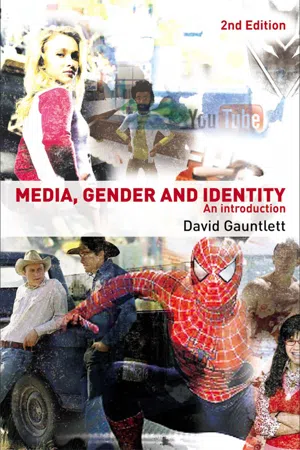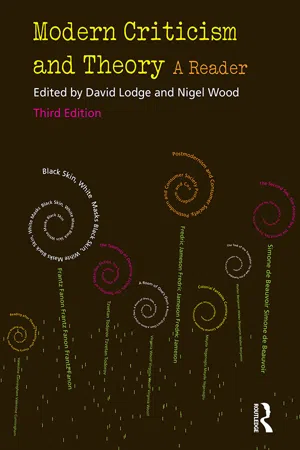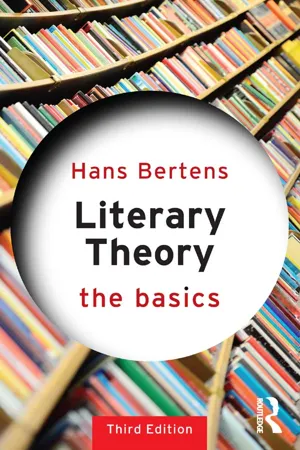Literature
Eve Kosofsky Sedgwick
Eve Kosofsky Sedgwick was a prominent literary critic and theorist known for her work in queer theory and gender studies. She is celebrated for her influential writings on the intersection of sexuality and literature, particularly her concept of "queer performativity" and her exploration of the closet as a metaphor for hidden or repressed identities. Sedgwick's work has had a lasting impact on literary and cultural studies.
Written by Perlego with AI-assistance
Related key terms
Related key terms
1 of 4
Related key terms
1 of 3
10 Key excerpts on "Eve Kosofsky Sedgwick"
- eBook - ePub
Critics at Work
Interviews 1993-2003
- Jeffrey J. Williams(Author)
- 2004(Publication Date)
- NYU Press(Publisher)
13Sedgwick Unplugged An Interview with Eve Kosofsky SedgwickBy the 1980s, contemporary criticism was demarcated by the major “schools” of theory—structuralism, deconstruction, feminism, Marxism, psychoanalysis, and reader response. Since the mid-eighties, Eve Kosofsky Sedgwick has been a central figure in redrawing the map of theory, forging the fields of gay studies and queer theory. In one sense, Sedgwick’s work is an expansion of feminism, as she discusses here. But at the same time, it is a critique of feminism, which focused on the relations between men and women. Instead, in her book Between Men: English Literature and Male Homosocial Desire , Sedgwick foregrounded “homosociality” or same-sex relations, and its underside, homophobia.In Epistemology of the Closet , one of the most influential critical books of the nineties, Sedgwick deconstructed the concepts of “heterosexuality” and “homosexuality,” arguing that the regime of secrecy they represented—the closet—undergirded modern thought. Drawing on poststructural theory, Sedgwick represents its revisionary tenor through the nineties; working from the concept of gender, Sedgwick has been influential in placing sexuality at the forefront of literary study.Born in Dayton, Ohio, in 1950, Sedgwick did her undergraduate work at Cornell (B.A., 1971) and graduate work at Yale (Ph.D., 1975) during the heyday of the “Yale School.” As she recounts here, she took seminars from Paul de Man, and one can discern the influence of deconstruction through her work. She taught at Boston University, Hamilton College, and Amherst College, but, after the publication of Between Men , she was one of those hired on at Duke, where she was Newman Ivey White Professor of English, during its heyday as a center of contemporary theory under the chairship of Stanley Fish (see also Fish’s interview in chapter 1 - Robert McMurray, Alison Pullen(Authors)
- 2019(Publication Date)
- Routledge(Publisher)
6 Witnessing EveEve Kosofsky Sedgwick
Saara L. TaalasEve Kosofsky Sedgwick (1950–2009) is generally recognized as one of the most prominent writers in the development of queer theory. Sedgwick was a literary critic, poet, textile arts experimenter and social theorist. Her influence on literary criticism and social theory simply cannot be conveyed in its entirety, and let me be clear that this is not my intention. Rather I am inspired by Sedgwick who vividly states:I think many adults (and I am one of them) are trying, in our work, to keep faith with vividly remembered promises made to ourselves in childhood: promises to make invisible possibilities and desire visible; to make the tacit things explicit; to smuggle queer presentations in where it must be smuggled and, with the relative freedom of adulthood, to challenge queer-eradicating impulses frontally where they are to be so challenged.(Sedgwick, 1994, p. 3)Rather, I would like to turn to the lingering question of why researchers in organization theory have not engaged with her work more broadly, although this is starting to change. Organization theory in recent years has shown a burgeoning interest in queer subjectivities and performativities (Parker, 2001; 2002; Rumens, 2016; 2017; 2018; Rippin, 2017), academic activism (Parker, 2001; Contu, 2017; Rippin, 2017) and the corporealities of affect (Fotaki, Kenny, and Vachhani, 2017).In view of this recent interest in queer performativities and in affect and organization, Sedgwick’s conceptual innovations certainly merit a closer look. However, I will not be conducting a full review of Sedgwick’s works but rather focusing on Rumens’s (2017) proposal that critical organization enquiry strikes up a friendship with queer theory. In this spirit, I would like to pick up some themes addressed in recent discussions on organization and see how Sedgwick’s contribution might help ‘destabilize management’ (Parker, 2001). The purpose of this destabilization is to mobilize subject positions in regenerative ways. To this end, I will draw my main inspiration from Sedgwick’s later works on queer performativity, which return to Austin’s (1975/1997) speech-act theory, develop the concept of the periperformative and offer an alternative strategy for critical enquiry in reparative readings, a topic covered in her last book, Touching Feeling – Affect, Pedagogy, Performative- Alison Pullen, Nancy Harding, Mary Phillips, Sarah Gilmore, Alison Pullen, Nancy Harding, Mary Phillips(Authors)
- 2017(Publication Date)
- Emerald Publishing Limited(Publisher)
CHAPTER 9
WRITING WITH EVE: QUEERING PAPER
Ann RippinABSTRACT
This chapter takes inspiration from Eve Kosofsky Sedgwick’s artistic work and academic writing to attend to some of the under-utilised dimensions of her work to date, that of making. Using unconventional methodologies from Sedgewick, I present my own unconventional methodologies to queer CMS. In this way through theory and making, we can queer CMS anew.Keywords: Unconventional methodologies; queer; CMS; SedgwickINTRODUCTION
I love Eve Kosofsky Sedgwick.This is an odd way to start a chapter in a book on critical thinking, because, love, affection, partiality often clouds our judgement, constituting the very obfuscation of clear analytical thinking we are trained to pursue. Love, however, seems to me to be the right place to start this chapter. This chapter is a celebration of the contribution of Eve Kosofsky Sedgwick to queering scholarship, not her theoretical contribution, which is widely appreciated (see Parker, 2002 , e.g., with regard to management studies), but her methodological and pedagogical challenge which is less well known. She had a brilliant, challenging mind, she also insisted that we came out of our heads and into our bodies; out of our theory and into making. In this way she embodied a praxis which, this chapter suggests, could reinvigorate Critical Management Studies.Eve Kosofsky Sedgwick was a pioneering exponent of queer theory, and she was a poet, artist, literary critic and teacher. I choose to emphasise the making elements of her work because this is where I think she has something to teach us about pumping life back into CMS. I will look at two elements of her work which receive far less attention than critical analyses of The Epistemology of the Closet, and Tendencies which include her theoretical work on queer theory. These two elements are A Dialogue on Love, her autobiographical account of her analysis following her diagnosis of cancer, in which she discusses her love of textiles, and a course she taught at the very end of her teaching career on artists’ books at the City University of New York.- eBook - ePub
- Jason Edwards(Author)
- 2008(Publication Date)
- Routledge(Publisher)
In Search of Lost Time (E: 212).SEDGWICK’S QUEER THEORETICAL CONTEXT
If you want to find out more about queer theory in general and Sedgwick’s position within it, take a look at Iain Morland and Annabelle Wilcox’s Queer Theory (2004), Nikki Sullivan’s A Critical Introduction to Queer Theory (2003), Riki Anne Wilchin’s Queer Theory, Gender Theory: An Instant Primer (2004) and Donald E. Hall’s Queer Theories (Transitions) (2002). You might also profitably work your way through Henry Abelove, Michèle Aina Barale and David M. Halperin’s The Lesbian and Gay Studies Reader (1993) and Susan Stryker and Stephen Whittle’s The Transgender Studies Reader (2006). In addition, the journal GLQ considers queer matters in a diverse array of theoretical and cultural contexts, and the recent ‘After Sex’ summer 2007 issue of the South Atlantic Quarterly is worth perusing to ascertain what happened to, or is currently happening in queer theory.Perhaps the most intelligent, concise guide to the history of queer theory and its precedents, particularly within art history, remains Whitney Davis’s ‘“Homosexualism”, Gay and Lesbian Studies, and Queer Theory in Art History’ (1998). In relation to questions of homo- and heteronormativity, Michael Warner’s Fear of a Queer Planet; Queer Politics and Social Theory (1993) is also required reading.THE HISTORY OF SEXUALITY
Sedgwick has repeatedly insisted that her work cannot be read in isolation from the texts that preceded, accompanied and inspired hers. Amongst the key sources in the history of sexuality you might look at are Allan Bloom's The Closing of the American Mind (1988), Alan Bray’s Homosexuality in Renaissance England (1988), John Boswell’s Christianity, Social Tolerance, and Homosexuality: Gay People in Western Europe from the Beginning of the Christian Era to the Fourteenth Century - eBook - ePub
Sexuality
A Psychosocial Manifesto
- Katherine Johnson(Author)
- 2015(Publication Date)
- Polity(Publisher)
Does orientating towards a queer perspective require the rejection of psychology? Certainly Sedgwick’s critique of ontogeny is difficult for some psychological approaches, but primarily for those that maintain a vision of psychology as a science based on a rigorous adherence to positivistic methods, which seek to establish causal or predictive relationships and universalizing truths for explaining human behaviour. Yet, an engagement with Sedgwick’s oeuvre suggests an outright rejection of psychology and psychoanalysis is too simplistic. Even though she was highly critical of both, throughout her career she made ‘“extravagant negotiations among the disparate, competing disciplines” called psychology and psychoanalysis, experimental, clinical, and applied alike’ (Edwards, 2008, p. 148), and she drew particular insight in her later work from the social psychologist Silvan Tomkins and the psychoanalyst Melanie Klein. As we have seen, Sedgwick was primarily concerned with developing an anti-homophobic stance, which she saw as dependent on six axioms. These can be summarized as: first, people are different from one another; second, even though gender and sexuality are related they are not coexistent and need to be untangled to understand where and how they overlap and where there is no relation; third, we cannot know in advance whether we should theorize lesbians and gay men together or separately; fourth, debates about nature versus nurture take place against an unstable fantasy of what they might explain; fifth, the search for a paradigm shift might mask the present conditions of sexual identity; sixth, the relation between gay studies and the literary canon is, and should be, tortuous.Taking these axioms as a starting point enables us to see points of connection between Sedgwick’s assumptions and that of psychology – not least in the first axiom that notes the importance of individual differences. Equally, within psychology and psychosocial studies, there are theoretical and methodological perspectives for engaging with sexuality beyond a positivist paradigm, as there are across the social sciences, which share a similar concern for how knowledge is produced. Sedgwick’s oeuvre, like most queer commentaries, uses skill in close textual analyses to illuminate alternative readings where identifications and desires of literary classics can be seen to cross gender lines. The textual turn within the social sciences, underpinned by poststructuralism also precipitated an increased awareness of the importance of close reading and analysis of discourse sought to demonstrate the relationship between language, power and representation (e.g. Potter and Wetherell, 1987; Fairclough, 1992; Hegarty, 2007). Nevertheless, the final axiom that highlights the relationship between gay studies and the literary canon is where we might see the least potential for overlap between queer theory and critical psychology or psychosocial engagement. For those working in the applied social sciences dense analyses of literature can seem distal from the everyday experiences of those who come to call themselves lesbian, gay, bisexual, transgendered or even queer. However, according to Jason Edwards (2008, p. 11) Sedgwick was also concerned that ‘the urgency, reach and power’ of her theoretical models might be limited by only utilizing examples from literary texts. To alleviate this, references to the most pressing contemporary social, cultural and political concerns of queer life, including AIDS and youth suicide, can be found throughout Sedgwick’s essays, which means that ‘any engagement with her work involves making a commitment to weave and interweave oneself among and between and through and beside the theoretical, the political and the personal’ (Giffney and O’Rourke, 2007, p. 8). - eBook - ePub
Queer Ideas
The David R. Kessler Lectures from 1992–2001
- CLAGS: Center for LGBTQ Studies(Author)
- 2023(Publication Date)
- The Feminist Press at CUNY(Publisher)
THE DAVID R. KESSLER LECTURES 1992–20011992JOAN NESTLE1993EDMUND WHITE1994BARBARA SMITH1995MONIQUE WITTIG1996ESTHER NEWTON1997SAMUEL R. DELANY1998Eve Kosofsky Sedgwick1999JOHN D’EMILIO2000CHERRÍE MORAGA2001JUDITH BUTLERPassage contains an image
Eve Kosofsky Sedgwick
Eve Kosofsky Sedgwick (1950–2009) was a poet, critical theorist, and artist. She was most recently Distinguished Professor of English at the Graduate Center of the City University of New York. Her authored publications include Between Men: English Literature and Male Homosocial Desire (1985), The Coherence of Gothic Conventions (1986), Epistemology of the Closet (1990), Tendencies (1993), Fat Art, Thin Art (1994), A Dialogue On Love (1999), Touching Feeling: Affect, Pedagogy, Performativity (2003), and The Weather in Proust (2011, edited by Jonathan Goldberg). Her edited collections include Performativity and Performance (1995, with Andrew Parker), Shame and Its Sisters: A Silvan Tomkins Reader (1995, with Adam Frank), Gary in Your Pocket (1996), and Novel Gazing: Queer Readings in Fiction (1997). Sedgwick was a contributing editor to MAMM: Women, Cancer, Community and was a founding editor of Series Q at Duke University Press. Her papers are held by the Rubenstein Library at Duke University. Her website is at EveKosofskySedgwick.net .A Dialogue on Love
In the waiting room, do I have a mental image of him at all? The handsome, lean, well-dressed therapists female and male in this large practice filter through the sunny room, greeting their patients, ushering them up or across.…I look expectantly at each of the men. And I’m trying now to remember it, the grotesque, reassuring shock of Shannon hovering down a few stairs into this view, mild and bristling with his soft gray nap,and wearing, I’ve no doubt, a beautifully ironedbig-faced, cherubic—barrel chest, long arms, short legs,Rumpelstiltskin-likeat his rotund waist. If it was as hot as Durham usually is in early September, he had a handkerchief too for mopping his forehead.short-sleeved cotton shirtthe color of an after-dinner mint, tucked in - eBook - ePub
Media, Gender and Identity
An Introduction
- David Gauntlett(Author)
- 2008(Publication Date)
- Routledge(Publisher)
Gender Trouble by Judith Butler. (Also important, within the version of queer theory which is concerned with literature rather than social identities, is the work of Eve Kosofsky Sedgwick, which challenges assumptions about sexuality in literature.)Figure 7.1 Judith ButlerIt is also worth mentioning that Butler is unlikely to win any awards for clarity of writing style. (On the contrary, indeed, she once won an annual international award for having produced the most incomprehensible academic text.) Her prose is unnecessarily dense and long-winded, and almost never fails to use jargon even where much more accessible vocabulary is available. Some people defend this, saying that academics should be allowed to develop complex terminology to express their sophisticated ideas – after all, nobody expects to read journals about rocket science and understand all of it straight away. However, although Butler’s writing is like an explosion in a dictionary factory, if one takes time to dig through the rubble one finds that her ideas are actually quite straightforward. So let’s get started.QUEER THEORY SUMMARY
We’ll need to look at each of these points in more detail to fully understand their meaning and implications, but here’s the simple summary of what queer theory is about:- Nothing within your identity is fixed.
- Your identity is little more than a pile of (social and cultural) things which you have previously expressed, or which have been said about you.
- There is not really an ‘inner self’. We come to believe we have one through the repetition of discourses about it.
- Gender, like other aspects of identity, is a performance (though not necessarily a consciously chosen one). Again, this is reinforced through repetition.
- eBook - ePub
Modern Criticism and Theory
A Reader
- Nigel Wood, David Lodge(Authors)
- 2014(Publication Date)
- Routledge(Publisher)
31 Eve Kosofsky Sedgwick
DOI: 10.4324/9781315835488-31Introductory note
Eve Kosofsky Sedgwick is Newman Ivey White Professor of English at Duke University. Her Between Men: English literature and male homosocial desire (1985) is widely regarded as a radical text in identifying the constraints of purely heterosexual definitions of sexuality. For Sedgwick, there are a whole host of effective relations between men that are not always genetic; homosociality is not only homosexuality. She rather attempts to trace a continuum between varieties of male bonding (including more formal brotherhoods) and homosexual behaviour, not so as to base the former on the latter, but ‘rather as a strategy for making generalizations about, and marking historical differences in, the structure of men’s relations with other men’ (Between Men, p. 2). Her main focus is on English literature of the late eighteenth to the early twentieth century. (In Between Men there is just one chapter on earlier cultural formations.) The point of this choice is that there was at that time a growing emphasis on the demarcation of clear gender identities, a heterogeneity that has given rise to modern gender distinctions.This is at its strongest in realist fiction, where the power of untheorized assumptions underpins an accepted set of (usually tacit) propositions as to just what ‘reality’ may be. This silence about the inevitability of same-sex relationships (which could stop short of sexual activity) runs like a transverse section through the male-authored texts Sedgwick analyses. Representations of the physicality of women provoke unstable responses that incorporate the extremes of intense attraction/repulsion. Sedgwick is at her most feminist when isolating the function of references to women within the closed system of homosocial relations: either they are a necessary product that eventually promotes male bonding or they help shore up certain patterns of gender difference that in effect promote homophobia, or they exist as a combination of the two. The removal of female agency from these paradigms helps also to reify certain passive female characteristics. There is a vested interest in policing such distinctions – to the point where what she terms ‘homosexual panic’ emerges: a flight from full individuality (because it might at certain points embrace the reprobated patterns of homosexuality) for the safety of traditional roles that do not threaten the enabling fictions of gender distinction. - eBook - ePub
- Hans Bertens(Author)
- 2017(Publication Date)
- Routledge(Publisher)
social relationships, not of sexual ones. Still, sexual classification in fixed categories is central to a homo-socially structured society. Sedgwick redefines, in Donald E. Hall' words, ‘heterosexuality as a fear of male homosexuality that motivates men to route their desire for another through women’ (Hall 2003: 198). For Sedgwick, the homosocial nature of the Victorian society on which she focuses, with its intimate connections between male sexual and non-sexual relationships, inevitably informs its writing: its literature, too, reveals that the underlying relationships of the Victorian period were relationships between men. Like the British queer theorists I have just mentioned, Sedgwick reads against the grain to bring to light what might be called a socio-sexual structure that is not immediately apparent.In a later book, Sedgwick proposes an equally wide-ranging thesis. Epistemology of the Closet (1990) begins with a classic Derridean deconstruction of the heterosexuality/homosexuality opposition (which in Western culture usually takes the form of contrasting naturalness, health, fertility, and other terms that stand for ‘life’ with artificiality, sickness, sterility, and death):The analytic move [this book] makes is to demonstrate that categories presented in a culture as symmetrical binary oppositions – heterosexual/homosexual, in this case – actually subsist in a more unsettled and dynamic tacit relation according to which, first, term B is not symmetrical with but subordinated to term A; but, second, the ontologically valorized term A actually depends for its meaning on the simultaneous subsumption and exclusion of term B; hence, third, the question of priority between the supposed central and the supposed marginal category of each dyad is irresolvably unstable, an instability caused by the fact that term B is constituted as at once internal and external to term A.(Sedgwick 1990: 9–10) Not just morally but theoretically, then, the privileging of hetero-sexuality turns out to be indefensible.Sedgwick goes on to subject contemporary views of homosexuality to a similar analysis, finding that those views are still ‘organized around a radical incoherence’ of which ‘the current impasse within gay theory between “constructivist” and “essentialist” understandings of homosexuality’ (91) is only one manifestation. We find ourselves, Sedgwick argues, in ‘a crisis of homo/heterosexual definition’ (11) that has been with us ever since the identification and categorization of homosexuality as such and that has strongly affected virtually every sphere of life. To the point, in fact, that - eBook - ePub
Freud's Jaw and Other Lost Objects
Fractured Subjectivity in the Face of Cancer
- Lana Lin(Author)
- 2017(Publication Date)
- Fordham University Press(Publisher)
70 For Sedgwick to discover writers, such as Tompkins and Proust, who captured so well her own sensibilities, was to feel loved by them. Her identification with their subjectivities, which mirrored her own, was a demonstration of her capacity to love and be loved. The give and take of the therapeutic exchange, not unlike the giving and taking of advice staged in “Off My Chest,” affirmed her ability to love and worthiness of love.Object-Use, Object-Love
Sedgwick’s public discourse of love, which she deployed to mediate her relationship to illness and mortality, can be further understood by examining the transference dynamics involved. No doubt transference, which Britzman identifies as “built from the analysand’s inchoate demand for love,” permeated Sedgwick’s therapy.71 When she reveals that “the space of Shannon is both myself and not,” Sedgwick’s blurring of self and other takes place in the transference where one cannot clearly discern one’s own voice from one’s parental figures, one’s lovers, and one’s therapists.72 The dual voices Sedgwick hears, talking to someone who is not quite herself and not quite other, signal the transference of her ingrained and inherited feelings onto Shannon. Freud came to see transference as itself a neurosis and called the transference neurosis an “artificial illness.”73 This transference neurosis induced by psychoanalysis has in common with slow moving or indolent cancers the characteristics of an incurable but not necessarily debilitating illness. Sedgwick suffers from both types of affliction, and Dialogue
Index pages curate the most relevant extracts from our library of academic textbooks. They’ve been created using an in-house natural language model (NLM), each adding context and meaning to key research topics.
Explore more topic indexes
Explore more topic indexes
1 of 6
Explore more topic indexes
1 of 4
